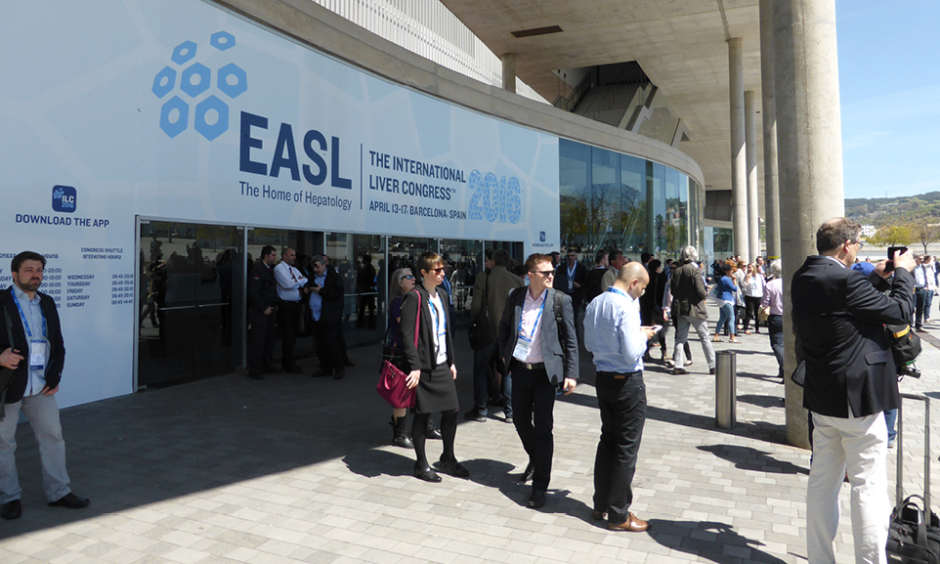The historic architecture of Barcelona, Spain, was the backdrop to this year’s annual ILC congress, marking its 51st birthday. The city of Barcelona welcomes around 8 million visitors every year, making it the third most visited city in Europe, and a perfect location for this prestigious event.
This year’s intake of visitors will include all 10,064 attendees of ILC 2016 from all over the globe, who descended on the city for 5 days of presentations, discussions, and debate on all aspects of hepatology practice and research. Nearly 3,000 abstracts were received and 1,580 were presented at the congress, with over 150 presented orally. This year saw more topics and posters presented, and more grants and fellowships awarded than ever before. Secretary General Dr Laurent Castera, University of Paris-XII, Clichy, France, talked of the growing presence of the European Association for the Study of the Liver (EASL) in European hepatology practice, saying: “We also started 50 years ago, as a small society, with less than 60 members, we are now more than 4,000 members from 109 countries!” He went on to announce the latest EASL clinical practice guidelines in non-alcoholic fatty liver disease, hepatitis C, and benign liver tumours.
As in previous years, awards were given in recognition of the outstanding contributions of individuals to liver disease care and research and this year there were three exceptional recipients. The first was Antonio Craxi, University of Palermo, Palermo, Italy, who has contributed extensively to research into hepatitis. Secondly, Roberto Groszmann, Yale School of Medicine, New Haven, Connecticut, USA, was acknowledged for his work in cirrhosis and portal hypertension. Last but certainly not least there was Jordi Bruix, University of Barcelona, Barcelona, Spain, who focusses on hepatic oncology.
Now in its second year, the Young Investigator Award seeks to acknowledge those who, whilst still in training, have already made a significant contribution to the international liver community. This year the award was given to two researchers. Firstly, to Jordi Gracia-Sancho, Barcelona, Spain, who presented an abstract on the maintenance of the hepatocyte phenotype in vitro using a superior microfluidic bioreactor to co-culture primary liver sinusoidal endothelial cells to produce a better phenotypic model than conventional methods. Veronika Lukacs-Kornek, Saarland University Medical Center, Homburg, Germany, received the second Young Investigator Award and presented an abstract that looked at the innate immunity contribution from toll-like receptor 4 stimulation on progenitor cell subset expansion during liver injury, finding that changes in genetic expression and oval cell activation occur.
There were also seven fellowships awarded to physician scientist, post-doctoral, and entry-level researchers. Three registry grants were awarded to: Jesus Banales, Biodonostia Institute, San Sebastián, Spain, for a registry collecting data on cholangiocarcinoma across Europe; Ken Simpson, University of Edinburgh, Edinburgh, UK, for a study into the epidemiology, management, and outcome of acute liver failure; and to Deirdre Anne Kelly, University of Birmingham, Birmingham, UK, for a study on long-term graft outcomes.
As always the standard of the work presented at the congress was exemplary and provided a unique opportunity to experience research highlights from across Europe. Amongst the presentations and topics on display were potential new treatment options for common hepatological conditions, such as hepatitis C and non-alcoholic fatty liver disease, which are sure to change the treatment landscape in the future.
In the following pages, you will find a review of some of the most significant research from the congress and a number of summaries of selected presentations that we hope will excite and refresh your perspective on the field.
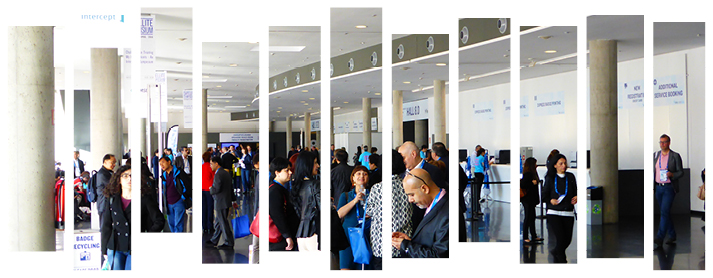
New Research Highlights the Potential for a Combined HIV and Hepatitis C Virus Vaccine
PRIME-BOOSTING, a sequential immunisation technique often compared to jump starting the immune system, has been shown to be compatible with co-administration of vectors encoding HIV and hepatitis C virus (HCV) antigens. This has highlighted the potential for a promising new combination vaccine against HIV and HCV.
HIV/HCV co-infection is a global issue, particularly in Europe where prevalence is extremely high and rising. With an estimated 2.3 million co-infected individuals identified worldwide, it currently represents the leading cause of non-AIDS death in co-infected individuals.
In an ILC press release dated 13th April 2016, Prof Lucy Dorrell, Principal Investigator, University of Oxford, Oxford, UK, explained: “While we have drugs to treat both HIV and HCV, these are out of reach for many and do not prevent re-infection.”
In the Phase I study healthy volunteers (N=32) were randomised in to one of three experimental groups. Volunteers received an investigational vaccination delivered intramuscularly at Weeks 0 and 8; volunteers in Group One received HCV only vaccines and Group Two volunteers received HIV only vaccines. HIV and HCV vaccinations were co-administered to Group Three volunteers, allowing observation of changes in immune response compared with either vaccine alone.
Immune response to vaccination was measured using a simple blood test which demonstrated a significant difference in HIV and HCV-specific T cells in the blood samples; where the peak means of 608.5 and 785 spot-forming units per million peripheral blood mononuclear cells (SFU/106 PBMC), respectively, were boosted to 4260 and 3760 SFU/106 PBMC, respectively. No impairment of the magnitude and breadth of either T cell responses were observed in Group Three compared to Groups One and Two.
Prof Ellie Barnes, Research Fellow, University of Oxford, Oxford, UK, states: “Knowing that it may be possible to vaccinate a single individual against both diseases opens up huge possibilities for rolling back epidemics of disease and co-infection.”
Hepatitis Prevalence Amongst Refugee Populations in Europe
HEPATITIS B is likely to increase in prevalence in Europe due to the high rates of the condition amongst new refugee populations, providing potential challenges to healthcare systems across Europe.
The number of refugees and asylum seekers entering the European Union has increased in the last year, with more than 1 million asylum applications in Germany alone. Many amongst these populations have left unstable and dangerous states, where healthcare systems are presently limited or non-existent.
A study tested 793 patients from all age groups for serological markers of hepatitis B (hepatitis B surface antigen [HBsAg] and hepatitis B core antibody [anti-HBc]), and liver enzymes (alanine transaminase [ALT], aspartate transaminase [AST], bilirubin, gamma glutamyl transpeptidase, alkaline phosphatase). The cohort was composed of patients living in refugee reception centres in Northern Germany in August 2015.
HBsAg was present in 2.3% of patients and anti-HBC in 14%, which indicates higher levels of hepatitis B infection than the German control group, but is consistent with other migrant groups working in Germany. Elevated ALT and AST were found in 15.9% and 5.8% of patients, respectively. Sixty-two percent had no immunity to hepatitis B and only 18.6% had been vaccinated. The prevalence of HBsAg was higher in males (2.5%) and in middle- aged and older patients (3.1%). Males were also more likely to have anti-HBC then females (14.5% and 13.5%, respectively). The highest reported levels were seen in patients >50 years (38%).
This data shows that Europe faces increased challenges in national and refugee health as Dr Philipp Solbach, Department of Gastroenterology, Hepatology, and Endocrinology, Hannover Medical School, Hannover, Germany, explained in an ILC press release dated 16th April 2016: “The prevalence of the data we have recorded, alongside decreased levels of immunity and non-immunisation, reveal the true extent of the public health challenge that Europe is facing with regard to hepatitis B.”

Four Out of Five Can Expect 20-Year Survival After Childhood Liver Transplant
SURVIVAL following a childhood liver transplant can now be estimated at 20 years for approximately four out of five patients, according to new data. A recent study looked at the medical records of children who received a liver transplant over a period of 5 years, with a mean follow-up of 22 years, in order to shed light on long-term outcomes.
“Until now there has been no good answer as to how long children could be expected to live after liver transplantation,” commented Dr Josefina Martinelli, Paediatric Liver Unit, AP-HP, Hospital Bicêtre, University Hospital South Paris, Paris, France, in an ILC press release dated 14th April 2016. “While each child receiving a transplant is unique and every procedure is different, this study provides robust evidence on the average expected survival rates, an important consideration for the parents of children who undergo this complicated procedure.”
In the study, the medical records of 128 consecutive children who received cadaveric transplantation (whole liver n=47, partial n=77, split n=4) in Bicêtre Hospital, Paris, France from 1988–1993 at a median age of 2.5 years were retrospectively analysed.
The team found that patient survival rates recorded at 5, 10, 15, and 20 years were 84%, 82%, 80%, and 79%, while graft survival rates were 73%, 72%, 67%, and 65%, respectively. They also discovered that the most common complications following surgery were infection (59%) as well as acute (44%) and chronic (37%) rejection. Chronic kidney disease Stage ≥2 was present in one-third of patients, however a total of 100 of the original 128 children survived ≥20 years following transplantation.
“This study is evidence of the great progress the medical community is making as we continue to learn more about how the body deals with transplanted organs,” commented Prof Laurent Castera, Department of Hepatology, Hôpital Beaujon, AP-HP, University of Paris-VII, Clichy, France.
Sofosbuvir and Ledipasvir may be Effective in Shorter Treatment Courses
SHORTER durations of treatment for hepatitis C virus (HCV) may soon be possible. Prof Heiner Wedemeyer and colleagues, Department of Gastroenterology, Hepatology and Endocrinology, Hannover Medical School, Hannover, Germany, studied the use of direct-acting antiviral treatments ledipasvir- sofosbuvir (LDV-SOF), focussing on whether treatment time could be reduced, a change which would also reduce the cost of therapy as well as the side effects. Acute HCV clears spontaneously in 10–50% of infected individuals, however early diagnosis rarely occurs in those who do not clear the infection, leading to serious liver damage.
There are a number of treatment regimens available for HCV, one of which is LDV-SOF. These regimens are normally prescribed for a 12-week period, following which patients are tested for a sustained virological response (SVR) to confirm the efficacy of the treatment. This 12-week treatment course currently results in a SVR in 95% of patients.
The study included 20 patients infected with HCV of various aetiologies: sexual transmission (n=11), medical procedures/needle stick (n=5), drug use (n=1), nail treatment complications (n=1), and unspecified (n=2). All 20 patients were given a 6-week course of LDV-SOF without ribavirin and 100% of these achieved SVR at the 12-week follow-up with no detectable HCV. Fatigue was a side effect in 30% of the participants.
In an ILC press release dated 16th April 2016, Prof Wedemeyer summarised, “our research demonstrates that not only is the combination of sofosbuvir and ledipasvir safe, well tolerated, and effective in acute HCV genotype 1 patients who have severe liver disease with very high liver enzymes, but a shorter treatment duration does not appear to hinder efficacy.”
These findings are encouraging and exciting for both patients and healthcare institutions as they may potentially reduce healthcare costs and the incidence of side effects that can occur during treatment. The findings now need to be validated in further studies with larger cohorts beyond this initial pilot study.

Community-Based Treatment Providers Boost Fight Against Hepatitis C
INNOVATIVE community-based treatment strategies, presented at ILC 2016, have provided successful treatment of hepatitis C virus (HCV)-infection to a range of patient subgroups in various non-specialist contexts, opening the doors to the therapeutic administration of hepatitis C treatment outside of the specialist setting.
HCV patients represent a large, global cohort in need of therapeutic treatment; providing this care in a safe and efficient manner is problematic as there currently exists a far smaller proportion of experienced specialists than can cater to the 130–150 million people across the world living with chronic HCV.
Responding to the constricted nature of current HCV care, a multicentre, open label, Phase IV clinical trial explored the outcomes of a standardised treatment for chronic HCV-infected patients across providers; specialists, primary care physicians, and nurse practitioners were given 3 hours of guideline training, after which the direct-acting antivirals, ledipasvir and sofosbuvir, were administered at community health centres across the USA. The cohort (N=304) included patients with genotype 1a (72%), co-infected with HIV and HCV (24%), and with cirrhosis (20%); 18% of the total cohort were treatment-experienced.
The results were promising; 93.8% of patients achieved a sustained virological response at 12 weeks (SVR12). Regardless of the particular treatment provider, SVR12 was achieved in >90% of the cohort, suggesting no significant difference in efficiency. “We know we have too few experienced specialists treating HCV, and this is severely hampering our ability to eradicate this disease once and for all. This research has the potential to be a genuine game changer in the way we look at HCV treatment across the board, and could provide the opportunity to increase access to care and treatment to many regions of the world,” asserted Prof Tom Hemming Karlsen, Department of Transplantation Medicine, Division of Cancer medicine, Surgery, and Transplantation, Oslo University Hospital Rikshospitalet, Oslo, Norway, in an ILC press release dated 13th April 2016.
Breastfeeding and Healthy Pre-Pregnancy BMI Rates Reduce Risk of NAFLD in Teenagers
BREASTFEEDING and maternal pre-pregnancy body mass index (BMI) rates significantly affect the chances of children developing non-alcoholic fatty liver disease (NAFLD) in their teenage years, according to a study presented at ILC 2016.
The results showed that healthy pre- pregnancy BMI levels and the exclusive breastfeeding of a child for at least 6 months can each reduce the risk of the onset of NAFLD in infants; a disease that can lead to scarring (fibrosis) of the liver and cirrhosis, a potentially life-threatening condition.
The research was conducted in light of the rising prevalence of NAFLD in children and adolescents. Factors that have been associated with this rise include excessive childhood weight gain.
The team used questionnaires, direct interviews, physical examinations, and blood tests to obtain data on maternal pregnancy, birth, childhood, and adolescent characteristics. Liver ultrasounds were carried out in 1,170 17-year-old participants to assess NAFLD status.
Over 15% (n=179) of the teenagers studied had NAFLD. A pre-pregnancy BMI within the normal range reduced the chances of developing this condition by half (odds ratio [OR]: 0.49, 95% confidence interval [CI]: 0.33–0.72, p=0.001). Those who were exclusively breastfed for ≥6 months had a one-third reduced risk of developing adolescent NAFLD compared with teenagers who had been breastfed for <6 months (OR: 0.66, 95% CI: 0.56–0.95, p=0.03). However, breastfeeding >9 months did not have any additional impact on the chances of NAFLD developing during adolescence (OR: 0.73, 95% CI: 0.46–1.16, p=0.18).
“Our results demonstrate the grave impact maternal factors can have on the risk of developing liver disease in adolescence,” commented Dr Oyekoya Ayonrinde, Clinical Senior Lecturer for Medicine and Pharmacology, University of Western Australia, Perth, Australia, in an ILC press release dated 13th April 2016. These findings demonstrate the need for proper nutrition and the benefit of exclusive and extended breastfeeding during infancy.

Waist Over Weight in Non-Alcoholic Liver Disease
WAIST circumference may be more important than weight or BMI in the development of non-alcoholic fatty liver disease (NAFLD) and the severe related complications, a recent study presented at ILC 2016 has shown.
Accumulation of fat around the liver can lead to cirrhosis, which results in impaired liver function. NAFLD is strongly linked with obesity and has a prevalence of up to 80% in obese patients. However, 16% of people with a normal body weight have NAFLD; this is known as ‘lean’ NAFLD and is linked with diabetes and hypertension. In an ILC press release dated 16th April 2016, Dr Rosa Lombardi, Unit of Internal Medicine, Policlinico Hospital, University of Milan, Milan, Italy, commented that “while NAFLD is commonly associated with obesity, research has highlighted that a percentage of patients are not obese.”
In this study of 323 patients with biopsy-confirmed NAFLD, the participants were divided in to groups based on waist circumference, abdominal fat, and BMI (<25 kg/m2 defined as lean-NAFLD). When considering those with a larger waist circumference, the study found that a waistline of >35 inches in women and a waistline of >40 inches in men was more strongly associated with metabolic syndrome (p=0.0001), carotid plaques (p=0.03), and significant liver fibrosis (p=0.03) compared with obese patients with NAFLD. This was consistent even in those with lean-NAFLD (who were a normal weight but had a larger waist circumference).
Dr Rosa Lombardi explained the novelty of these results: “This is the first study to show that patients with lean-NAFLD who have increased levels of waist fat can in fact be at greater risk than obese patients with NAFLD.”
Further research is needed to analyse the mechanisms by which this may occur and the best method for detecting an individual’s risk of developing the disease or the allied metabolic, cardiovascular, and tissue complications.
Capsid Assembly Inhibitor Provides Novel Treatment for Hepatitis B
A FIRST-IN-CLASS drug named NVR 3-778 has been confirmed as a novel treatment for chronic hepatitis B following promising results from a study presented at ILC 2016.
An estimated 14 million people are chronically infected with the hepatitis B virus (HBV) in the World Health Organization (WHO) European region. Many treatment options are available and effective at suppressing the virus but they rarely clear the condition permanently.
NVR 3-778 is a viral capsid assembly inhibitor, which modulates the core protein function. This Phase Ib trial included a cohort of 64 treatment-naïve HBV-infected patients. The patients received treatment for a period of 28 days. They were separated into six dosing groups: three receiving 100, 200, or 400 mg of NVR 3-778 daily; two groups were treated with NVR 3-778 600 mg twice daily, either with or without pegylated interferon (PEG-INF), and a final group received PEG-INF combined with placebo.
A dose-related reduction in HBV DNA was observed, the largest of which occurred in the 600 mg plus PEG-INF group (1.97 log IU/mL). Patients who received NVR 3-778 alone had a 1.72 log IU/mL decrease in the 600 mg twice daily group; the control group had a decline of 1.06 log IU/mL. All groups tolerated the drug well and there were no discontinuations; most adverse events were mild and not ascribed to NVR 3-778. Researchers also noted early reductions in hepatitis B eantigen levels, which were greatest in the NVR 3-788 group.
While further research is required, these results are a step towards improved treatment as Prof Man-Fung Yuen, Department of Gastroenterology and Hepatology, Queen Mary Hospital, University of Hong Kong, Hong Kong, commented in an ILC press release dated 16th April 2016: “It is promising to see that the combination of NVR 3-778 with PEG-INF produces responses that are greater than those seen with either monotherapy.”

Long-Term Use of NUCS Therapy Increases Risk of Colorectal and Cervical Cancers
PROLONGED treatment with nucleos(t)ide analogues (NUCS) in patients with chronic hepatitis B virus (HBV) infection has been statistically linked to an increased risk of developing colorectal and cervical cancer.
The burden of chronic HBV infection is felt worldwide, and there is constant demand for the development of new approaches to management and prevention. NUCS inhibit viral reproduction and are thus often used as a therapeutic strategy for patients presenting with chronic HBV. Despite their efficacy in suppressing the spread of viral infections, long-term administration of NUCS can cause serious adverse events in chronic HBV patients.
A recent study, presented at ILC 2016, investigated potential associations between the treatment and various malignancies. The primary outcome in this study was incident malignancies with the exception of hepatocellular carcinoma. A large cohort of 45,299 chronic HBV patients, 16.16% of whom had received NUCS treatment (n=7,323), were followed for up to 7 years, measuring the relative risk of the primary outcome.
At median follow-up (4.4 years), malignancies were found in 2.1% and 5.7% of patients in the NUCS-naïve and NUCS-treated cohorts, respectively. Though, when examined at a higher resolution, the analysis revealed a specific risk pattern for HBV patients treated with NUCS. “Although our analysis showed that NUCS treatment does not increase overall incidence of liver, lung, breast, and urinary/renal malignancies, it did reveal that patients with HBV on this treatment had a higher risk of developing colorectal and cervical cancers,” clarified Prof Grace Wong, Department of Medicine and Therapeutics, The Chinese University of Hong Kong, Hong Kong, China, in an ILC press release dated 15th April 2016.
The statistical risk of developing cervical and colorectal cancers was demonstrated as significant, with adjusted hazard ratios of 4.41 and 2.17; 95% confidence intervals of 1.01–19.34 and 1.08–4.36; and p-values of 0.049 and 0.029, respectively. As a result, the long-term safety of NUCS treatment for HBV patients has been called into question.
High Rates of Liver Cancer Recurrence in Hepatitis C Patients Taking Antiviral Drugs
PATIENTS who have successfully battled hepatocellular carcinoma (HCC) in the past have a high rate of recurrence if they are taking direct-acting antiviral treatments (DAAs) to treat hepatitis C, according to data presented at ILC 2016.
Liver cancer, of which HCC is the most common form, accounts for 662,000 deaths worldwide. The vast majority of HCC cases occur in patients with chronic liver disease, and approximately 80–90% have cirrhosis; most within the remaining 10% have moderate-to-advanced fibrosis.
Researchers from Italy analysed the medical records of 344 HIV-negative patients with hepatitis C virus-related cirrhosis who did not have active HCC. The patients had received one of the following DAA combinations: sofosbuvir and simeprevir (34%); 3D combination, which comprises ABT-450 with ritonavir, ombitasvir, dasabuvir, and ribavirin (22%); sofosbuvir and ribavirin (17%); sofosbuvir and daclatasvir (16%); and sofosbuvir and ledipasvir (10%). To assess the rates of HCC occurrence in these patients, baseline enhanced-ultrasonography and MRI/CT-scans were compared with those taken during the 6-month post-treatment follow-up.
A sustained virological response was achieved in 89% of patients at 12 weeks post-treatment. At the same time, active HCC was found in 7.6% of all patients (n=26) with no history of HCC at 24 weeks post-treatment. Most significantly, 29% of the patients who had a previous history of HCC experienced a recurrence.
While these findings need to be investigated further, the results suggest that HCV patients taking DAAs will require a greater level of scrutiny for signs of HCC onset in the future, and could be used to develop management strategies for high-risk patients.
“Even in a relatively short observation period, we have shown that high recurrence rates of HCC can occur in HCV patients taking DAAs,” said Dr Federica Buonfiglioli, Department of Medical and Surgical Sciences, University of Bologna, Bologna, Italy, in an ILC press release dated 13th April 2016.

Coffee Consumption Could Help Fight Non-Alcoholic Fatty Liver Disease
SYMPTOMS of non-alcoholic fatty liver (NAFLD) could be alleviated by the consumption of coffee, researchers have discovered. In a study conducted on three groups of mice, scientists found that mice that consumed a daily dose of coffee alongside a high-fat diet displayed an improvement in several key markers of the disease as well as gaining less weight than those mice that did not consume any coffee.
Researchers analysed three different groups of mice over a 12-week period. Group One mice were fed a standard diet, Group Two a high-fat diet, and Group Three was given a high-fat diet plus a decaffeinated coffee solution equivalent to six cups of espresso coffee for a 70 kg person.
The results of the study showed significantly reversed levels of cholesterol (p<0.001), alanine aminotransferase (p<0.05), steatosis (p<0.001), and ballooning degeneration (p<0.028) in the third group. The scientists also showed how coffee protects against NAFLD by raising levels of zonulin (ZO)-1, which reduces the permeability of the gut; increased gut permeability is believed to be a factor in liver injury and the advancement of NAFLD.
“Previous studies have confirmed how coffee can reverse the damage of NAFLD but this is the first to demonstrate that it can influence the permeability of the intestine,” stated Dr Vincenzo Lembo, University of Naples Federico II, Naples, Italy.
“Italy is famous for its coffee and this Italian study has reinforced our knowledge on the link between it and NAFLD. Although not suggesting that we should consume greater levels of coffee, the study offers insights that can help future research into, and understanding of, the therapeutic role coffee can play in combating NAFLD,” commented Prof Laurent Castera, Department of Hepatology, Hôpital Beaujon, AP-HP, University of Paris-VII, Paris, France, in an ILC press release dated 13th April 2016.
Scoring System Defines Non-Alcoholic Fatty Liver Disease Mortality Risk
ACCURATE prediction of a patient’s risk of death from non-alcoholic fatty liver disease (NAFLD) has been enabled through the development of a new scoring system, named ‘SAF’, which combines three individual measures of liver function; as announced by a research team at ILC 2016.
NAFLD is the most common form of liver disease worldwide; closely associated with obesity and diabetes, the accumulation of fat in the liver causes inflammation and cirrhosis, leading to decreased liver function. Although an increased risk of death has long been associated with NAFLD, this study, conducted over a long-term follow-up period, offers a technique for individual patient risk stratification.
The SAF scoring system combines data on liver steatosis, activity, and fibrosis from a simple questionnaire. Its efficacy was tested via a statistical study of 139 biopsy-proven NAFLD patients, which used a Cox regression model, adjusted for body mass index and the presence of Type 2 diabetes, to explore patient survival over an average of 26 years (standard deviation: 6.1, range: 1.7–40.8 years). At baseline, 69 patients presented with a severe form of NAFLD, whilst 35 were classified as exhibiting mild or moderate disease. Over the follow-up period 70 patients died, 59% of whom were originally defined as presenting with severe NAFLD.
“We suspected that steatosis, activity, and fibrosis were important to overall risk but we wanted to validate their impact on mortality over a long-term follow-up period through a validated and simple scoring system,” explained lead author Dr Hannes Hagström, Unit for Inflammation, Gastroenterology and Rheumatology, Department of Medicine, Karolinska University Hospital, Stockholm, Sweden, in an ILC press release dated 14th April 2016. The Cox regression model allows predictions of treatment effect on survival as Dr Hagström confirmed: “This new analysis is vital in showing the link between severe NAFLD and mortality, which is an important measure given that this is the most common liver disease worldwide.”
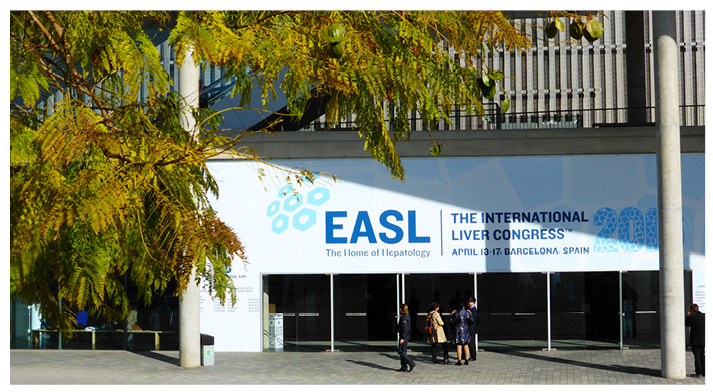
Algorithm Predicts End-Stage Liver Disease Treatment Outcomes
CALCULATING the potential failure of treatment for end-stage liver disease (ESLD) has recently become an algorithmic reality, thanks to a recent study of cirrhosis patients.
A topical issue in medicine today is pragmatic decision-making regarding treatment strategy for individuals. “When patients are very ill, physicians must ensure that our concern for the patient should not result in the recommendation of treatment that will be of no benefit,” said Dr Katrine Lindvig, Research Assistant, Medical Gastroenterology, University of South Denmark, Odense, Denmark, in an ILC press release dated 15th April 2016.
A new predictive algorithm, presented at ILC 2016, combines a measure of pre-morbid liver function with the Acute-on-Chronic Liver Failure (ACLF) grade. ACLF can be differentiated from decompensated cirrhosis in a number of ways; patients with ACLF are typically younger, present with more alcohol-related than hepatitis C virus-induced scarring of the liver, and have increased rates of organ failure and mortality. ACLF is not uncommon, occurring in 31% of patients with cirrhosis and acute complications, who are hospitalised, also being their most common cause of death.
In this regard, physicians must decide whether or not an ESLD patient will survive and benefit from intensive care unit (ICU) treatment, a choice that, as previously mentioned, can prove difficult. To develop a predictive algorithm, the researchers used scales such as Child–Pugh, Model for End-Stage Liver Disease, and CLIF-SOFA-score data, pertaining to severity of disease, urgency of, and success of transplant, respectively, from 354 hospitalised cirrhosis patients. The algorithm isolated two groups within the cohort: those likely to benefit and survive and those unlikely to benefit or survive ICU treatment, and these outcomes were accurately predicted in 96% of patients (odds ratio: 4.7; 95% confidence interval: 2.50–9.05).
“We now have well validated data that allows us to more accurately predict who is likely to benefit from treatment compared with previous measures,” concluded Dr Lindvig.
A New Potential Treatment Option for Primary Sclerosing Cholangitis
A NOVEL treatment, known as norursodeoxycholic acid, may soon become available for primary sclerosing cholangitis (PSC), a condition for which there are currently no therapeutic options; according to a study presented at ILC 2016.
In PSC, liver tissue can become damaged, as a build-up of bile acids, and consequent blockage of the bile ducts, leads to accumulation of bile in the liver. In the EU, approximately 6.3 per 100,000 people are affected, with symptoms ranging from itching and fatigue to cirrhosis, hypertension, liver failure, and in the later stages, liver cancer. As such, there is a dire need for efficacious treatments.
Recently a multicentre, randomised, double-blind, Phase II trial evaluated the use of norursodeoxycholic acid in PSC, enrolling 159 patients with elevated serum alkaline phosphatase (which is increased in the presence of liver disease). Patients were randomised into four groups receiving 500, 1,000, or 1,500 mg of norursodeoxycholic acid, or placebo, administered for 12 weeks with a 4-week follow-up with any treatment.
Efficacy was measured using the primary endpoint: mean relative change in serum alkaline phosphatase between baseline and end of treatment in the intention-to-treat groups. There was a reduction in serum alkaline phosphatase in all groups, with a 12.3% reduction in the 500 mg group (p=0.0029), 17.3% in the 1,000 mg group (p=0.0003), and 26% in the 1,500 mg group (p<0.0001).
Adverse event rates were similar across all the groups; pruritus occurred at low frequencies. Prof Michael Trauner, Lead Author, Division of Gastroenterology and Hepatology, Medical University Vienna, Vienna, Austria, commented in an ILC press release dated 16th April 2016: “Our study demonstrates that norursodeoxycholic acid could be a viable treatment option for patients with this chronic and debilitating condition.”
This treatment could provide relief for the ~82,000 patients in Europe who suffer from the condition. A larger scale Phase III trial is required to examine the safety and efficacy in larger cohorts.
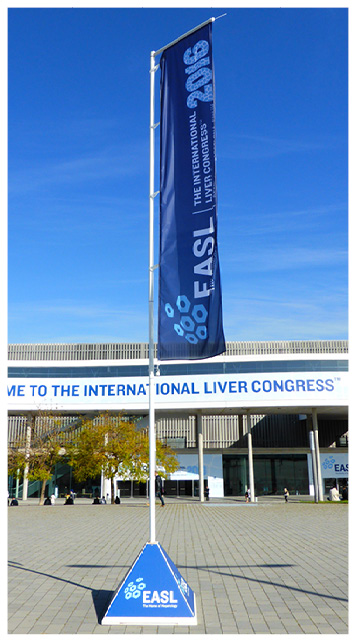
New Triple-Combination Drug Shows Promise for Treating Genotype 1 Hepatitis C
A COMBINATION of sofosbuvir, velpatasvir, and the investigational drug GS-9857 with or without ribavirin has been shown to be safe and effective in the treatment of hepatitis C patients whose prior treatment with direct-acting antivirals (DAAs) failed. In a recent study, the drug combination resulted in high rates of sustained virological response 12 weeks after treatment (SVR12) in genotype 1 hepatitis C patients who had previously received and failed treatment with DAAs.
In the study, a total of 49 patients were randomised to treatment, of whom 65% were male and 88% had hepatitis C virus genotype 1a. Forty-one percent of the patients examined had previously received an NS5A inhibitor, and 47% of patients had previously received at least two classes of DAA. The primary endpoint of the study was SVR12.
SVR12 was achieved in 100% of patients who took sofosbuvir, velpatasvir, and GS-9857 without ribavirin, and in 96% of patients who received ribavirin.
The triple combination proved to be generally safe and well-tolerated. The researchers recorded only one serious adverse event while two patients discontinued treatment with ribavirin due to adverse effects. Fatigue and anaemia were the most frequent adverse effects; however, they were only observed in patients that received ribavirin.
“This new combination of treatments could add to our arsenal of therapies for patients with hepatitis C, a disease which could eventually be eradicated. In the hard-to-treat patient population who had previously failed on existing treatment regimens, the combination with GS-9857 could provide these people with another hope,” commented Prof Tom Hemming Karlsen, Department of Transplantation Medicine, Division of Cancer medicine, Surgery, and Transplantation, Oslo University Hospital Rikshospitalet, Oslo, Norway, in an ILC press release dated 14th April 2016.
Genotype 3 Hepatitis C: Is ABT the Answer?
HOPE for the difficult-to-treat genotype 3 hepatitis C patient group has been found in experimental drugs ABT-493 and ABT-530. Whilst progress has been made in the treatment of genotype 1 using direct-acting antiviral therapies, there remains much room for improvement in the treatment of genotype 3 patients.
The current therapy for genotype 3 is sofosbuvir, a nucleotide polymerase inhibitor, combined with weight-based ribavirin (RBV) for 24 weeks. Evidence supporting the use of this treatment originates from the Valence study where high sustained virological response (SVR) rates (~92%) were seen in treatment-naïve patients, however treatment-experienced patients achieved lower SVR rates (60%).
New research highlights the potential of this new therapeutic treatment via a Phase II study that enrolled 24 cirrhotic, treatment-naïve patients to two study arms. These two groups took oral ABT-493 and ABT-530 with and without daily RBV, achieving SVR in 100% of patients after 12 weeks. In a third trial arm, including 29 non-cirrhotic, genotype 3 patients, 97% of patients achieved SVR after only 8 weeks. None of the patients experienced virological failure, although some side effects were observed, including headache and fatigue.
Prof Paul Kwo, Department of Gastroenterology, Indiana University School of Medicine, Indianapolis, Indiana, USA, commented in an ILC press release dated 16th April 2016: “We are pleased to see the efficacy of this two direct-acting antiviral investigational, pan-genotypic regimen has been validated for treatment-naïve hepatitis C genotypic 3 patients, with 100% of cirrhotic patients treated for 12 weeks and 97% of non-cirrhotic patients treated for 8 weeks achieving SVR at 12 weeks post-treatment.”
Although clinical use of these regimens continues to be assessed across different cohorts, these findings represent a promising alternative treatment for patients worldwide. Dr Kwo explained: “Clinical trials are ongoing to evaluate the safety and efficacy of the investigational treatment, and we are now focussing on a larger cohort of HCV genotype 3 patients, including treatment- experienced patients.”

Immunotherapy Offers Effective Treatment for Hepatitis D Patients
CHRONIC hepatitis delta (D) infection can be ameliorated using biologic therapy, a study presented at ILC 2016 has recently confirmed.
“There has been significant debate over whether there are long-term benefits to patients with hepatitis D receiving antiviral treatment,” explained Dr Anika Wranke, Fellow of Hannover Medical School, Hannover, Germany, in an ILC press release dated 15th April 2016. Hepatitis D is a severe condition that emerges from hepatitis B disease progression. The dual infection worsens patient outcomes, and a recent study was interested in exploring the efficacy of interferon alpha (IFN-α) therapy in comparison to nucleos(t)ide analogues (NUCS) treatment, a common option for treating hepatitis B.
Out of 136 chronic hepatitis D patients chosen for the study, 40% presented clinical endpoints at baseline. These included ascites (fluid accumulation causing abdominal swelling), oesophageal bleeding (enlarged veins that bleed in the oesophagus), encephalitis (brain inflammation), (hepatocellular carcinoma), liver transplant, or death. The cohort was followed for 6 months, with a median follow-up of 5 years, and the study compared the frequency of these clinical endpoints in patients receiving IFN-- therapies (n=52) to those who received NUCS or no treatment. Within the IFN--based therapy subgroup, 35% achieved a sustained suppression of hepatitis D, and clinical endpoints were less frequent than in other subgroups. The study therefore highlighted the significance of the European Association for the Study of the Liver (EASL) guidelines, which recommend pegylated interferon therapy as the only effective treatment for hepatitis D.
“Our study demonstrates that the long-term outcomes for patients with severe hepatitis D, who have limited treatment options, could be improved with a widely available medication,” asserted Dr Wranke. Such progress is very promising for hepatitis D patients, and future research will aim to further improve immunotherapies for the treatment of this dual infection.
Genetic Markers Highlight Increased Risk of Alcoholic Hepatitis
MUTATIONS in two genes have been linked with an increased susceptibility to severe alcoholic hepatitis according to a study presented at ILC 2016.
Severe alcoholic hepatitis is a serious syndrome with a high rate of mortality; globally, hepatic cirrhosis due to alcohol- related liver disease (ARLD) claimed almost 500,000 lives in the year 2010, at a male to female ratio of roughly 2:1. Within this global pattern, the World Health Organization (WHO) has deemed Europe the region with the heaviest drinking. The lack of a specific treatment strategy and the <50% chance of survival by 5 years which characterise this syndrome are thus concerning.
In light of these observations, a two-stage genome-wide association study (GWAS) aimed to explore genetic risk associations with the syndrome, which is just one of the complex range of ARLD manifestations. “Given that the spectrum of ARLD varies widely, with the majority of patients being asymptomatic, we were interested to find out why a small proportion of these people go on to develop severe alcoholic hepatitis,” stated Dr Stephen Atkinson, Department of Surgery and Cancer, Imperial College, London, UK, in an ILC press release dated 14th April 2016.
By rapidly scanning for markers across comparative genome sets of patients with severe alcoholic hepatitis (n=860) and alcohol-dependent subjects without liver disease (n=1191), the study isolated a variant of the PNPLA3 gene, which was significantly associated with an increased risk of developing severe alcoholic hepatitis. Furthermore, a specific mutation of the SLC38A4 gene was found to be another indicator of risk.
This research is just one example of the potential use of genetics on the development of robust treatment strategies for common yet complex diseases. “This first analysis of data means that we may now be able to use genetic profiles to identify people who are at increased risk of developing severe alcoholic hepatitis,” concluded Dr Atkinson.
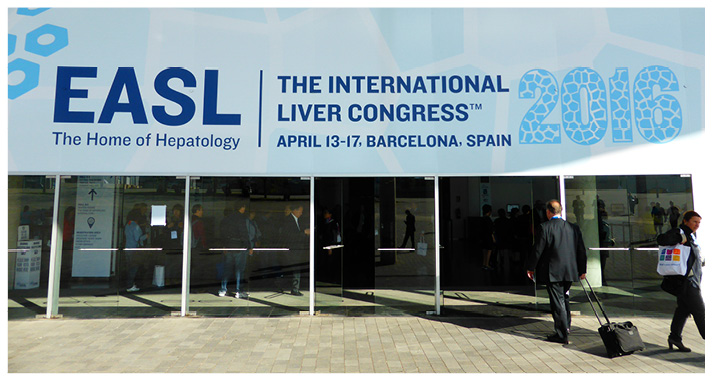
Livers Infected with Hepatitis C Prove Effective in Transplant Patients
MORTALITY in hepatitis C virus (HCV) patients receiving a HCV-positive liver transplant does not significantly differ from those receiving a healthy liver, a long-term study has revealed.
Liver organs for transplant are in high demand, with over 20,000 people on the waiting list across Europe and the USA. From 2013–2014 the demand increased by 12% in the UK alone, and figures from the USA suggest that around 16% of patients will die whilst waiting. Healthy donor livers are hard come by, and in response to the growing number of HCV cases, the use of HCV-positive donor livers has also increased; from 1995–2013 their use has tripled in the USA.
Using the Scientific Registry of Transplant Recipients, data on the medium to long-term outcomes of 33,668 adult transplant patients receiving both HCV-positive and HCV-negative livers were compared. Spanning from 1995–2013, the recent study examined both long-term graft loss and mortality in this cohort, with 5.7% of patients receiving a HCV-positive liver. In a promising turn for transplant waiting list patients, the results demonstrated no difference in the amount of time to post-transplant death between those receiving an HCV-infected or healthy liver.
“Our study clearly shows that people with HCV who received HCV-positive livers had the same medium to long-term outcomes as people that received healthy livers. As highly effective treatments for HCV are available for transplanted patients, the future of these patients is bright,” explained lead author of the study Prof Zobair Younossi, Chairman of Department of Medicine, Inova Fairfax Hospital, Falls Church, Virginia, USA, in an ILC press release dated 14th April 2016.
In light of the rapidly increasing number of people with HCV, this study has demonstrated the potential for greater use of available HCV-positive organs and post-transplant HCV treatment.
Current Controversies in the Treatment of Hepatitis C/HIV Co-infected Patients
THE INCREASINGLY high number of individuals co-infected with HIV and hepatitis C virus (HCV) is an issue worldwide and the complex drug interactions between direct-acting antiviral (DAA) and antiretroviral medications remain a concern.
In research, conflicting results are common. This was exemplified by two recent studies; a Spanish, prospective, multi-cohort study demonstrated that HIV negatively impacts rates of response to DAAs in co-infected patients, whereas a real-word, retrospective US veterans’ health administration study found no statistically significant impact of HIV co-infection on achievement of a sustained virological response at 12 weeks (SVR12).
Dr Karin Neukam, Unit of Infectious diseases and Microbiology, University Hospital of Valme, Seville, Spain, commented of the Spanish trial: “Our study demonstrates the impact of HIV co-infection on the effectiveness of DAA-based treatment. We must keep a close eye on co-infected patients to ensure that they receive the treatment they need.” The study of 1,276 patients found that the efficacy primary outcome, SVR12, was less likely to be met in HIV/HCV co-infected patients; the SVR12 rate was 11% lower in patients treated using interferon-based DAAs and 6% lower in those treated with interferon-free DAAs compared with HCV only patients.
Conversely, in the US real-world retrospective study (N=408 patients, most of whom had HCV genotype 1), SVR12 rates exceeding 88% were observed post-treatment. Patients were treated with a combination of therapies (either simeprevir/sofosbuvir, ledipasvir/sofosbuvir, or ombitasvir/paritaprevir/ritonavir/dasabuvir) and researchers performed logistic regression analysis, controlling for patient demographics, disease severity, and other comorbidities.
“We know that these patients are at increased risk of liver disease progression from their HCV status, and these data suggest the co-infected patient group could benefit from treatment,” stated Mr Justin McGinnis, University of South Carolina, Columbia, South Carolina, USA, in an ILC press release dated 13th April 2016.
These contradictory results indicate an ongoing need for the study of HCV treatment in HIV co-infected patients.

